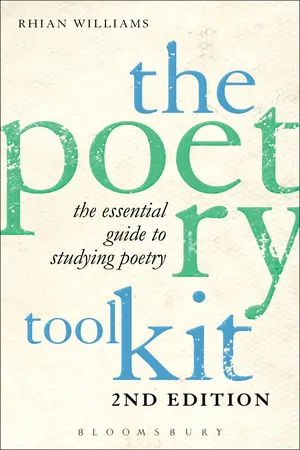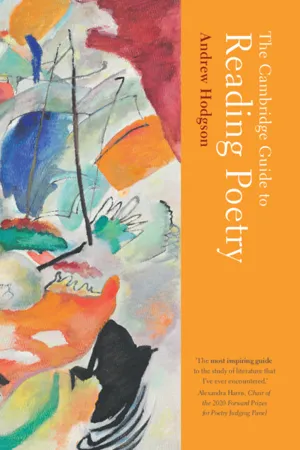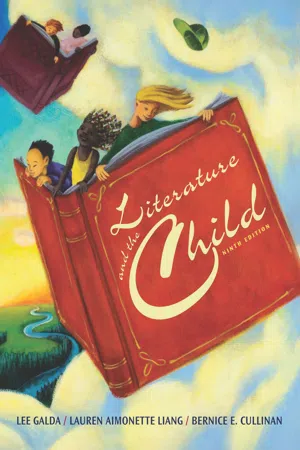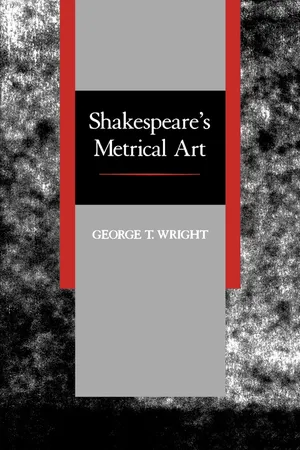Literature
Verse
A verse is a single line of poetry or a stanza within a poem. It is characterized by its rhythm, meter, and often rhyme scheme. Verses are used to convey emotions, ideas, and imagery in a structured and artistic manner.
Written by Perlego with AI-assistance
Related key terms
1 of 5
8 Key excerpts on "Verse"
- eBook - PDF
- Rhian Williams(Author)
- 2013(Publication Date)
- Bloomsbury Academic(Publisher)
It is particularly prevalent in the ballad tradition, and in the fixed French forms such as the villanelle and the ballade , but they also feature in lyric poems Stanza A group of poetic lines, defined by its arrangement of metre and rhyme . Feet, lines and rhymes of poetry have been considered; now we come to how all of these features come together into particular poetic arrangements. ‘Stanza’ is the name given to blocks of formal poetry; commonly these blocks are called ‘Verses’ (especially with reference to songs), but stanza is clearer. (Note however that in blank Verse such divisions are known as Verse paragraphs .) ‘Stanza’ is often etymologically linked via Latin to the Italian for ‘stopping place’, but the term also applies in Italy to a chamber or room and this latter root is more helpful in thinking about the definition of a stanza of poetry. We may think that a room is most obviously defined by its function and content (beds in bedrooms; ovens in kitchens). Framing this functional definition, however, is a room’s dimensions (the length of its walls) and its decor. A stanza’s line lengths may be likened to its ‘walls’ (which form a particular set of dimensions on the page) and the rhyme scheme , which decorates the line lengths, becomes the wallpaper. In this section stanzas are arranged primarily in terms of their dimensions – the number of lines included in each – since all stanzas may be described most simply in this way. In certain fixed or named stanza arrangements the rhyme scheme or metre is specified, so these are also given in each definition. 5.1 One-line stanzas and refrains Stanza 183 as a case of heightened or concentrated emotion. A famous example is Alfred Tennyson’s ‘Lady of Shalott’ (1832), in which the subject’s name is repeated as a refrain in the final line of every stanza . - No longer available |Learn more
- Joseph Black, Leonard Conolly, Kate Flint, Isobel Grundy, Don LePan, Roy Liuzza, Jerome McGann, Anne Lake Prescott, Barry Qualls, Claire Waters(Authors)
- 2012(Publication Date)
- Broadview Press(Publisher)
POETIC FORMS In poetry, language is intimately related to form, which is the structuring of words within identifiable patterns. In prose we speak of phrases, sentences, and paragraphs; in poetry, we identify structures by lines, stanzas, or complete forms such as the sonnet or the ode (though poetry in complete or blank Verse has paragraphs of variable length, not formal stanzas: see below). Rightly handled, the form enhances expression and meaning, just as a frame can define and enhance a painting or photograph. Unlike the photo frame, however, form in poetry is an integral part of the whole work. At one end of the scale, the term “form” may describe the epic, the lengthy narrative governed by such conventions as division into books, a lofty style, and the interplay between human and Reading Poetry 925 supernatural characters. At the other end lies the epigram , a witty and pointed saying whose distinguishing characteristic is its brevity, as in Alexander Pope’s famous couplet, I am his Highness’ dog at Kew; Pray tell me sir, whose dog are you? Between the epic and the epigram lie many other poetic forms, such as the sonnet, the ballad, or the ode. “Form” may also describe stanzaic patterns like couplets and quatrains . “ FIXED FORM ” POEMS The best-known poetic form is probably the sonnet, the fourteen-line poem inherited from Italy (the word itself is from the Italian sonetto , little song or sound). Within those fourteen lines, whether the poet chooses the “Petrarchan” rhyme scheme or the “English” form (see below in the section on “Rhyme”), the challenge is to develop an idea or situation that must find its statement and its resolution within the strict confines of the sonnet frame. Typically, there is an initial idea, description, or statement of feeling, followed by a “turn” in the thought that takes the reader by surprise, or that casts the situation in an unexpected light. - eBook - PDF
Roots of Lyric
Primitive Poetry and Modern Poetics
- Andrew Welsh(Author)
- 2019(Publication Date)
- Princeton University Press(Publisher)
The roots of meter, he felt, lie in those external rhythms that have always been used to form language to the measures of music: The rhythmic form of Verse is the same in its essential principles as that of the music of song, from which it is, in fact, derived in the first instance. In some kinds of Verse, it is true, the form is much more remote from that of song than in others. For example, our English blank Verse and the French Alexandrine line have been made, more or less deliberately, as unlike song as Verse can ever be; and indeed all Verse meant to be used in long poems or to be spoken in anything like the level of tone of prose discourse must have been treated in the same way. Still, the changes that have been intro-duced into our spoken Verse, as we may call it, have not affected the fundamental principles of rhythm which it derives from song; they are merely additional procedures which restrict the operation of these prin-ciples within certain limits, without changing them in any way or adding new ones to them. Meanwhile a great deal of poetry continues and will always continue to be made as much like song as possible. Dancing and R H Y T H M music are the arts of rhythm; they have nothing to learn about their own business from poetry; poetry, on the other hand, has derived all it knows about rhythm from them. The best way to approach the study of the rhythm of Verse, therefore, is by way of the form of song. 1 Poetic meter is seen here as fundamentally musical meas-ure, and it is best notated by time signatures, bar lines, notes which indicate syllable duration, and rests. Both versions of poetic meter recognize that a metrical pattern does not tell us the whole story of the rhythm in a line of poetry. In fact, the most valued effects of meter in poetry occur not when the language corresponds with docile regularity to the metrical pattern, but on those oc-casions when rhythms in the language challenge and con-flict with that regular pattern. - eBook - PDF
- Andrew Hodgson(Author)
- 2021(Publication Date)
- Cambridge University Press(Publisher)
Free Verse doesn’t mean the absence of form, but rather the pursuit of a form whose shape and movement is not predetermined and is free to follow closely the contours of thought, feeling, and experience rather than the stipulations of any metrical or rhyming pattern. It finds a rhythm and a pattern of its own. Verse can be irregular without being ‘free’. Here are some lines from the start of T. E. Brown’s ‘Dartmoor: Sunset at Chagford’ (1900): Is it ironical, a fool enigma, This sunset show? The purple stigma, Black mountain cut upon a saffron glow– Is it a mammoth joke, A riddle put for me to guess, Which having duly honoured, I may smoke, And go to bed, And snore, Having a soothing consciousness Of something red? Or is it more? Ah, is it, is it more? The presence of rhyme and metre mean that it would not be accurate to call this Verse ‘free’, but it nevertheless approaches the distinctive ‘texture’ 132 Reading a Poem Leavis had in mind: the patterns of lineation and rhyme move unpredict- ably, in sympathy with the wavering attitudes of the poet as he tries to determine the significance of the sunset. The impulse to dismiss the beauty as a trivial ‘riddle’ sees the lines dwindle to a monometer (‘And snore’); the yearning suspicion that the sight might communicate something ‘more’ (the presence of God, say) sees the lines expand, accompanied by the reiterative energy of the rhyming couplet, at the end of the paragraph. - eBook - PDF
- Lee Galda, , Lauren Liang, Bernice Cullinan, Lee Galda, Lauren Liang, Bernice Cullinan(Authors)
- 2016(Publication Date)
- Cengage Learning EMEA(Publisher)
There is some controversy about whether Verse novels are really poetry. They certainly resemble poetry, with condensed language saturated with poetic devices. Campbell (2004) points out that the rhythms found in Verse novels are more often that of ordinary speech than of formal metrics, but this is true of much other poetry as well. The best Verse novels go well beyond the criticism of being merely prose chopped into short lines. Verse novels, like so many other literary forms, do not fit neatly under one general category. They do all tell a story, but vary widely within that descrip-tion. Some Verse novels consist of free Verse, as in Karen Hesse’s Out of the Dust ( A ), Lindsay Lee Johnson’s Soul Moon Soup ( A ), Andrea Cheng’s Where the Steps Were ( I ), and Janet Wong’s Minn and Jake ( I ), but poets also explore various forms of poetry to great effect. Ron Koertge’s Shakespeare Bats Cleanup ( A ), Sharon Creech’s Love that Dog ( I ) and the sequel Hate that Cat ( I ), Nikki Grimes’s Bronx Masquerade ( A ), and Jacqueline Woodson’s Locomotion ( I) contain poems in a variety of forms, with the narrators experimenting with a form as they are learning how poetry can help them come to terms with an emotional crisis in their lives. In Love that Dog ( I ) and Hate that Cat ( I ), the narrator, Jack, uses poems by various writers as models as he strug-gles to come to terms with the death of his beloved pet. His biggest inspiration is Walter Dean Myers’s poem “Love that Boy” and the writer behind it. Elizabeth Alexander and Marilyn Nelson work within a sonnet form while also innovating on that form in Miss Crandall’s School for Young Ladies & Little Misses of Color: Poems ( A ). Multiple voices of students and Floyd Cooper’s illustrations combine to tell the story of the violent history of this school begun in Connecticut in the 1830s. Margarita Engle’s The Poet Slave of Cuba: A Biography of Juan Fran-cisco Manzano ( A ) is another riveting biography in Verse. - eBook - PDF
- George T. Wright(Author)
- 1988(Publication Date)
- University of California Press(Publisher)
Verse does not belong on the stage. It is too distract-ing, artificial, estranging, to suit a theater of illusion and empathy. At best 94 The Verse of Shakespeare's Theater it may fit a Brechtian drama of alienation and deliberate challenge. Even Eliot recognized how strongly an audience is likely to resist Verse drama. Casting his own plays in a Verse whose rhyme soon disappeared and whose meter grew less and less identifiable, he believed that a modern writer of dramatic poetry had to proceed by disguising, possum-like, the fact that he was writing in Verse at all. 1 But the Elizabethan theater was different; its plays were traditionally in Verse. Throughout the fifteenth century and most of the sixteenth, English drama, whether play or interlude, folk or court, was mainly writ-ten in rhyming forms—in loose tetrameter couplets, rime royal, rime couee, ballad measure, poulter's measure, and the like. The lines were often crude and irregular, and the rhymes roughly measured exuberant strips of language: See! here is all the thought that the foolysh urchyn taketh! And Tyb, me thinke, at his elbowe almost as mery maketh! This is all the wyt ye have, when others make their mone. Come downe, Hodge! Where art thou? And let the cat alone! (Gammer Gurton's Needle, 1.5.28-31, in Adams, 474-75) Is he gone? Now, by the gods, I will doo as I say! My lord, therefore fill me some wine, I hartely you pray; For I must drinke to make my braine somewhat intoxicate. When that the wine is in my head, O, trimly I can prate! (Cambists, lines 525-28, in Adams, 651) For unsophisticated spectators, the rhymes must have come down with a pounce. Much of this Verse, true to the name later given it, has the same effect as clowns tumbling at a circus. The first rhyme sets us up for a pratfall, and the second meets this expectation with mindless good nature. Experienced readers or viewers may tire of such an empty-headed game. - eBook - PDF
- John Singleton, Mary Luckhurst, John Singleton, Mary Luckhurst(Authors)
- 2000(Publication Date)
- Bloomsbury Academic(Publisher)
The lines, and the groups, may be regular in one or another way, as in limericks and sonnets; or they may be irregular, creating a new form 164 WRITING Verse 165 unique to that poem: but in all cases there is a form, so again the choice is not whether to have a form, but whether you attend to the form. Poetry has varied enormously over time (as you can see by paging through the Norton Anthology), and because people have often been taught poetry narrowly at school there are common misconceptions about 'what poetry is'. Before the twentieth century most poetry in English was written in regu-lar metres (or patterns of stress), so that each line has a similar rhythm; and in prescribed forms, so all the lines are either of the same length, or vary in a regular way. Poems of this kind often have a regular pattern of end-rhymes (called the rhyme scheme): but this does not mean that 'all poems rhyme', nor that 'if it rhymes it's a poem'; and in the twentieth century (especially since T. S. Eliot's The Waste Land [1922]: N1236) free Verse (where the metrical pattern varies from line to line) and open form (where the line lengths and rhyme scheme are ir-regular) have become increasingly popular. There is still metre, and form: but they are freed from preset rules and limits. You may want to write more traditional poetry (and many poets, like Tony Harrison, have continued to use regular metres and forms), or you may want to experiment with free Verse, but in either case you will need to understand metre and form, to make them regular or to control their irregularities. Metre and form are very general terms, and each can be subdivided in many ways (some of which are explored in the Workshop Writing and Writing On sections). - eBook - PDF
Best Words, Best Order
Essays on Poetry
- S. Dobyns(Author)
- 2016(Publication Date)
- Palgrave Macmillan(Publisher)
So far we have discussed the background of free Verse and how it was encouraged by the social and political life of the turn of the century. Abrupt change, a flood of information, immense en- ergy-these remain common in the 1990s. Free Verse still reflects our times, although we have lost the sense of promise and enthusiasm found early in the century. On the other hand, the popularity of metered Verse in the 1940s and 1980s perhaps bears out Paul Fussell's claim that metered Verse is more popular during politically conservative periods. Two other aspects of free Verse need to be stressed before continuing. First of all, free Verse develops out of the idea of organic form-that the true poet's rhythms are always personal- an idea that we have seen evolve from Coleridge, through Whit- man and the French Symbolists and wind up as Pound's idea of absolute rhythm. The extreme effect is to make a different prosody for every poet, which is what formalist critics dislike. It keeps free Verse from being sufficiently accountable; it makes free Verse I 06 I Best Words, Best Order impossible to categorize and codify. Indeed, this apparent lack of accountability is a common complaint against free Verse. The second important aspect of free Verse is that through its diction and syntax, it often aims for verisimilitude. Although clearly artificial speech, it attempts to capture the realism and apparent spontaneity of natural speech. One of the criticisms that advocates of free Verse make against metered Verse is that stylized language is a distortion of reality. Remember that Baudelaire wrote that "the artifices of rhythm are an insurmountable obstacle to that detailed development of thoughts and expressions whose purpose is truth." 154 He was attempting to prove that the end of poetry was not truth but beauty. But later we find those values reVersed; perhaps this was partly due to the nature of the society.
Index pages curate the most relevant extracts from our library of academic textbooks. They’ve been created using an in-house natural language model (NLM), each adding context and meaning to key research topics.







